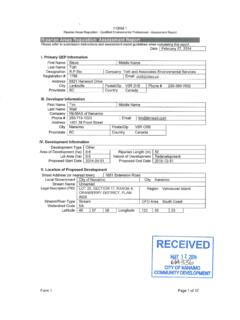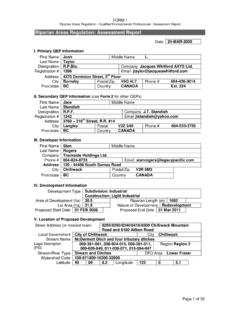Transcription of City of Burnaby Guide for Developing Near Streams
1 City of Burnaby Guide for Developing Near Streams Last Updated: October 2019 City of Burnaby Guide for Developing Near Streams Updated: October 2019 Page 2 Table of Contents Introduction .. 3 Regulatory 3 City Review Process for Streamside Protection and Enhancement Areas (SPEAs) .. 4 ERC Type 1 Applications (Local area Plans, Rezoning, Subdivision, PPA, Fill Permit), and ERC Type 2 Applications (Single or Two-Family Residential Development) .. 5 ERC Type 3 Applications: Infrastructure Development ( utility corridors, new capital infrastructure development*, communications infrastructure) .. 6 Considerations for Review .. 8 Existing Permanent Structures and Development within a SPEA .. 11 Frequently Asked Questions .. 12 Appendix A Burnaby Streamside Protection and Enhancement Areas Bylaw (Zoning Bylaw ) .. 14 Appendix B Determining the Width of the Streamside Protection and Enhancement area (SPEA).
2 17 Appendix C Environmental Review Committee Guide for Applicants .. 19 Appendix D Guidelines for riparian Planting and Signage .. 25 City of Burnaby Guide for Developing Near Streams Updated: October 2019 Page 3 Introduction The purpose of this Guide is to outline the City of Burnaby streamside development review process. The audience for the Guide is City and agency staff, landowners, and developers. The Guide is a living document, and is updated as needed. Streams , including many types of watercourses and water bodies, are important to the City and its citizens for providing habitat for fish and wildlife, aesthetic and recreational values, and other benefits to society. These aquatic ecosystems depend not only on protection of water quality and the stream channel itself, but also on healthy adjacent vegetation in order to stabilize stream and ravine banks, provide shade to maintain cool water temperature, and provide a source of food and nutrients to the Streams .
3 For this reason, the City ensures that development setbacks are established in order to provide for these features, functions and conditions, consistent with fisheries regulations and best practices. Accordingly, the City s Zoning Bylaw defines the Streamside Protection and Enhancement area as an area adjacent to a stream that links aquatic to terrestrial ecosystems and includes both the riparian area vegetation and the adjacent upland vegetation that exerts an influence on the stream. Other types of environmentally sensitive areas, such as forests, are identified in the City s Official Community Plan as Green Zones. Development within these areas is subject to review and implementation of the Planning and Design Principles for ESAs, approved by Council in 1995, and may also be subject to Environmental Review Committee review.
4 Refer to the City website for additional information about Developing around environmentally sensitive areas. Regulatory Context The Federal Fisheries Act (1985) is the highest level of government regulation protecting fish habitat. The Act prohibits harmful alteration, disruption or destruction of fish habitat and non-compliance is enforceable through criminal prosecution. To provide guidance to landowners and developers for protecting fish habitat from development impacts, in 1992, the provincial and federal governments published the Land Development Guidelines for Protection of Aquatic Habitat, which included recommended setbacks. The City of Burnaby has implemented these guidelines, in part through an Environmental Review Committee (ERC) process, since that time. In 2005 the provincial government enacted the riparian Areas Regulation (RAR), under the provincial Fish Protection Act, replacing the earlier Streamside Protection Regulation (2001).
5 The RAR outlines requirements for establishing development setbacks from Streams , lakes and wetlands. To comply with provincial and federal regulations , and ensure a high standard of environmental protection, the City of Burnaby established the Streamside Protection and Enhancement Areas (SPEA) Bylaw (Zoning Bylaw Section ; Appendix A of this document). This Bylaw outlines setback requirements, and is administered by the City Planning Department. The Environmental Review Committee (ERC) consists of City staff and reviews applications for development in environmentally sensitive areas, including applications for variances to the setbacks defined in the Bylaw. City of Burnaby Guide for Developing Near Streams Updated: October 2019 Page 4 The goal of the ERC in relation to streamside development is to ensure compliance with Section of the Zoning Bylaw as well as federal and provincial environmental regulations , and to provide a timely and coordinated review of development applications, in the context of strategic City plans.
6 City Review Process for Streamside Protection and Enhancement Areas (SPEAs) Setbacks for Streamside Protection and Enhancement Areas (SPEAs) apply to all types of development within the City, and should be considered early in the development planning process. Review by the Planning Department for applicability of the SPEA Bylaw is triggered when development is proposed within 30m of the top of bank of a stream or ravine, the riparian assessment area . Proponents may inquire directly to the Planning Department for this review, or may be referred internally from other departments. Note: development is defined in the Zoning Bylaw as a change in the use of any land, building or structure for any purpose and shall include the carrying out of any building, engineering, construction or other operation in, on, over or under land, or the construction, addition, or alteration of any building or structure.
7 The SPEA Bylaw therefore applies in many cases even if a building permit or development permit is not required ( construction of retaining walls, driveways, underground utilities and significant vegetation clearing or changes to landscaping). As outlined on page 11, maintenance of existing structures and landscaping within a SPEA is allowed under the Bylaw. The Planning Department coordinates streamside planning for development applications, including for Community Plans, Rezoning, Subdivision and Preliminary Plan Approval applications (Type 1 Applications); for review of Building Permits for single and two-family development (Type 2 Applications); and for general review of other types of development in environmentally sensitive areas (Type 3 Applications). If an owner applies for a Building Permit for a property that is potentially affected by a setback for a stream on or adjacent to the property, the file is forwarded to the Planning Department for review.
8 City projects involving development in or near riparian areas are also subject to the SPEA Bylaw and in some cases to broader environmental impact assessment and mitigation strategies. This includes construction of new buildings, trails, parking lots, playing fields, and associated infrastructure, or other significant change or disturbance to the vegetation/soils within riparian areas. Maintenance of existing structures and routine works within riparian areas by the City, such as sediment removal from established collection ponds, culvert replacement, road work, bridge replacement, maintenance of existing infrastructure or trails/landscaping, and riparian restoration by the City, may be processed via direct review and Notification of DFO and MoE. Review of infrastructure development by other agencies ( utilities, regional government) may be undertaken via the ERC and/or through interdepartmental City review, usually coordinated by either the Planning Department or Engineering Department, often in consultation with the Parks Department.
9 The steps and considerations below are applicable to most types of development within 30m of the Top of Bank or Top of Ravine Bank of a stream, in order to meet the intent and requirements of the City Zoning Bylaw. City of Burnaby Guide for Developing Near Streams Updated: October 2019 Page 5 NOTE: Stream includes a watercourse or source of water supply, whether usually containing water or not, a pond, lake, river, creek, brook, ditch and a spring or wetland that is integral to a stream and provides fish habitat ( Burnaby Zoning Bylaw Section ). In low-gradient areas where the topographic Top of Bank is not obvious, the Top of Bank is measured from the edge of the active floodplain, as determined by a qualified environmental professional, based on riparian vegetation as well as soil and water indicators.
10 The edge of the active floodplain for wetlands is delineated based on accepted ecological field indicators and wetland classification. ERC Type 1 Applications (Local area Plans, Rezoning, Subdivision, PPA, Fill Permit), and ERC Type 2 Applications (Single or Two-Family Residential Development) Process (see also Figure 1) 1. If development is proposed within 30m of a stream or ravine, contact the City of Burnaby Planning Department to confirm the required Streamside Protection and Enhancement area (SPEA or streamside setback) according to the Bylaw, and whether an Environmental Review would be required in order to carry out the proposed development. In some cases, proponents may need to supply additional information, such as a survey plan, at this stage. If the development CAN be carried out without encroachment into the SPEA, staff will advise that the project may proceed, sometimes subject to conditions for protection of the SPEA, and/or other City requirements.











